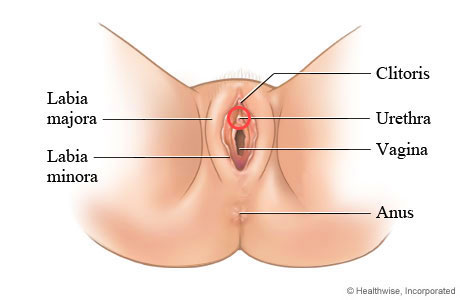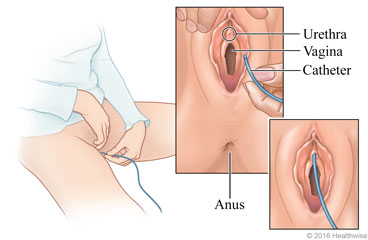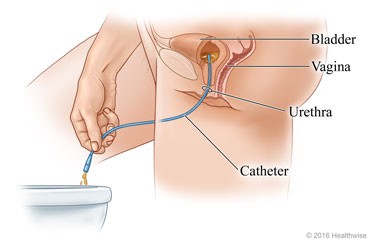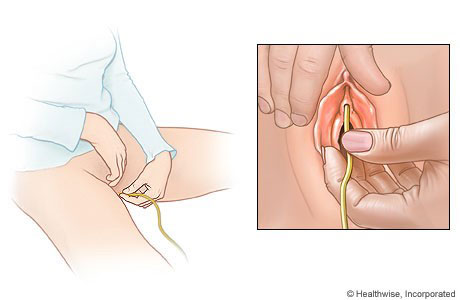1. Gather supplies.
Gather all your supplies and put them in a place that’s easy to reach once you start intermittent self-catheterization (ISC). See
Section 4: Supplies you need for ISC to find a supply list.
2. Wash your hands.
Wash your hands really well with soap and water. This helps prevent urinary tract infections.
3. Make sure everything is ready.
Put all your supplies where you can reach them.
4. Choose a position.
Decide what position you’ll be in when you insert the catheter (see
Section 6: Positions for ISC). You can stand, squat, or sit—whichever is more comfortable for you.
You can try standing over the toilet, standing in front of the toilet, sitting in a chair beside the toilet, or sitting on the side of the tub. You can even lie back on a bed (put a towel under you) with the mirror and container to collect urine (pee) between your legs.
5. Wash your hands again.
You’re almost ready to start.
6. Get into your position and look closely at your body.
Using a mirror can help you see your urethra and help you put the catheter in the right place.
Gently part the labia open with your non-dominant hand (the hand you don’t write with) and find the urethra (urinary opening). This is in between the clitoris and the opening of the vagina.

7. Clean the area.
Wash your labia and urethra with your dominant hand (the hand you write with). It’s important to remember to wash from top to bottom or front to back, from the clitoris towards the anus, using a warm wet washcloth. Do
not wash back and forth.
You can also use a fresh antiseptic towelette or a baby wipe. Don’t use soap as it can irritate the area.
8. Put one end of the catheter in the container or over the toilet or tub.
Depending on your position and if you need to measure how much urine you’ve collected, you may be emptying your bladder into a container, toilet, or bathtub. Put one end of the catheter over the toilet bowl, in the tub, or in the container to catch the urine.
9. Put the catheter in.
With your dominant hand, pick up the catheter and dip the tip into the lubricant, such as KY jelly.
Keep holding the labia apart with your non-dominant hand.
Holding the catheter like a pen, gently slide it into your urethra until urine starts to flow. Do not force the catheter. Start over if it is not going in easily. Remember to relax and breathe.
Once the catheter is in the bladder, urine should start to flow into the toilet or container.


10. Take the catheter out.
When the urine stops flowing, pinch the end of the catheter closed to stop any urine from leaking out. Then slowly remove the catheter. You may then put it in the garbage or wash it using the instructions you were given.
Wash your hands.
Be sure to note how much urine you’ve collected, if you’ve been asked to do this (see
Section 7: Monitoring your output).
Support
Always learn how to do self-catheterization with the help of a healthcare provider. You will get the chance to practice putting in a catheter by yourself. A nurse, who is an expert at it, will help you. When you’re doing self-catheterization at home, you can contact your healthcare provider or Health Link at 811 if you have any concerns or problems.

